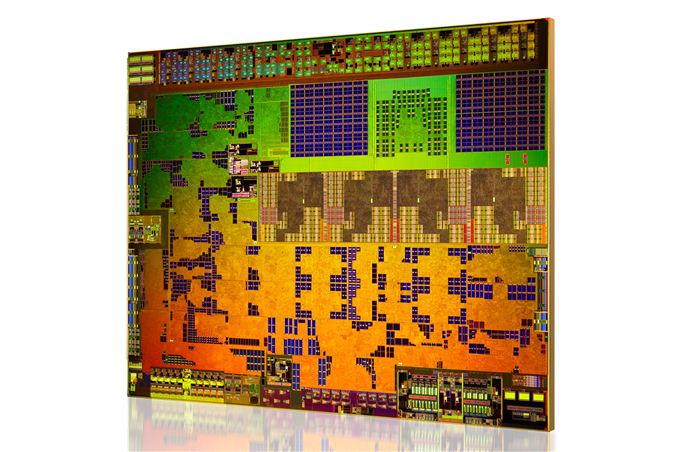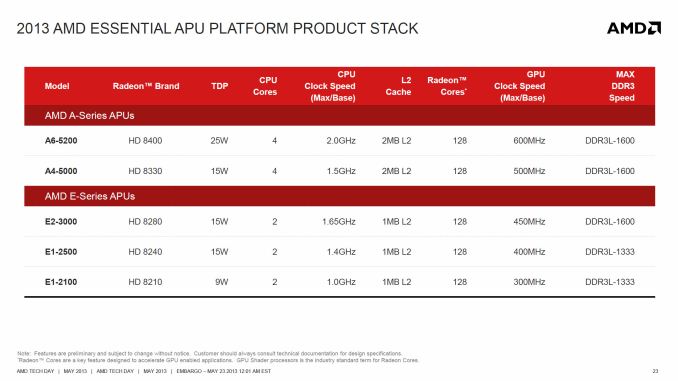The AMD Kabini Review: A4-5000 APU Tested
by Jarred Walton on May 23, 2013 12:00 AM EST
Anand is covering AMD’s latest Kabini/Temash architecture in a separate article, but here we get to tackle the more practical question: how does Kabini perform compared to existing hardware? Armed (sorry, bad pun) with a prototype laptop sporting AMD’s latest APU, we put it through an extensive suite of benchmarks and see what’s changed since Brazos, how Kabini stacks up against Intel’s current ULV offerings, and where it falls relative to ARM offerings and Clover Trail. But first, let’s talk about what’s launching today.
AMD has a three-pronged assault going out today: at the bottom (in terms of performance) is their 2013 AMD Elite Mobility Platform, formerly codenamed Temash. The main subject of this review is the newly christened 2013 AMD Mainstream APU Platform, aka Kabini. And at the higher end of the spectrum we’re also getting the Richland update to Trinity, which AMD is calling their 2013 Elite Performance APU Platform. We’ll cover all of these with Pipeline pieces, but here’s the overview of the Kabini parts:
In total there are five new Kabini APUs launching: one 25W part, three 15W parts, and one 9W offering. The hardware is the same from the architectural side of things, with the A-Series parts coming with four Jaguar CPU cores and supporting DDR3L-1600 while the E-Series will be dual-core with DDR3L-1333 on two of the models and DDR3L-1600 on the highest performance option. The GPUs in all cases will be fully enabled 128 core GCN architecture parts, but clock speeds range from 300MHz on the 9W part up to 600MHz on the 25W part, with the 15W parts filling in at clocks of 400-500MHz.
AMD provided plenty of material to discuss, and as usual there’s a lot of marketing material that we don’t need to get into too much. For those of you that want to see the AMD slides, though, here’s the full Kabini presentation gallery. Or if you're really interested, I've put the full 2013 Mobility Platforms deck into our galleries.

















130 Comments
View All Comments
MrSpadge - Thursday, May 23, 2013 - link
It's a shame for Anandtech that AMD didn't include a dual channel controller on the die? Weird.HalloweenJack - Thursday, May 23, 2013 - link
rubbish Kabini includes dual channel on die - the `prototype` doesn't use it. which is ofc a shame , and if anandtech wasn't being paid by intel or employed intel staff on its website , they would likely have added another stick to show the improvement gained.t.s - Thursday, May 23, 2013 - link
"Just to call out a couple noteworthy items, first is the single-channel memory configuration. In theory that could be hampering performance somewhat, but we have no real way of knowing. While the laptop does support two SO-DIMMs, Kabini only supports a single-channel interface, so adding a second SO-DIMM wouldn't help." --Page 2So, Whose right? If Kabini indeed support dual channel on die, then yes, it's a shame. Knowing it will raise the bar for AMD and intentionally didn't include it with testbed in the review.
GuMeshow - Thursday, May 23, 2013 - link
Kabini does not "include dual channel on die". All the websites i've seen say "Kabini features a single 64-bit DDR3 memory controller", two SO-DIMM sockets does not mean two channels ... Unless i'm mistaken and if that is the case i would ask for your source on that.lmcd - Thursday, May 23, 2013 - link
No, you're right. HalloweenJack is spreading FUD instead of candy.Spunjji - Friday, May 24, 2013 - link
Tool.johnny_boy - Tuesday, May 28, 2013 - link
I wondered the same thing, but I thought "shame on AMD". Why would they be that retarded though? I don't get it.johnny_boy - Tuesday, May 28, 2013 - link
I get it now, after having read the comments. I should also read the article.whyso - Thursday, May 23, 2013 - link
I believe that kabini is typically $42-72, though I can't find the linkpolyzp - Thursday, May 23, 2013 - link
AMD back in the High End with Steamroller! Check out the benchmarkshttp://amdfx.blogspot.ca/2013/05/amd-steamroller-f...